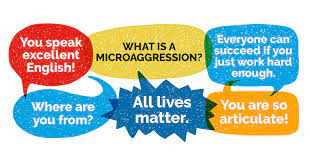Microaggressions in School Settings

December 1, 2021
Microaggressions; most people know little to nothing about them. According to a survey at Briar Woods, 50% of the student body isn’t familiar with the term ‘microaggressions’, while only 44.4% are not.
What is a microaggression? According to Webster’s Dictionary, a microaggression is a statement, action, or incident regarded as an instance of indirect, subtle, or unintentional discrimination against members of a marginalized group such as a racial or ethnic minority.
Let’s look at a couple of examples of microaggressions. Picture a white woman in an elevator heading up to the tenth floor. She might be standing with her arms next to her sides and thinking about where she wants to go for lunch later that day. Suddenly, the elevator stops on the fifth floor and a handsome tall, dark black man enters. The woman takes a step to the side, casts her eyes downward, and clutches her pocketbook a little more tightly. Some may say the entrance of the man and the clutching of the purse are unrelated, but are they?
Let’s look at another scenario. It’s Monday, and a 15-year-old student is conversing with her classmate. Her ebony fingers are clutching her pen as she helps the new boy, who just arrived from Maine and is suffering from a stinging sunburn from his weekend on the beach. “Your English is really good,” says the bright red boy, adding, “You sound so proper when you speak… not like others I’ve met.” Many black people speak in AAVE, also known as African American Vernacular English. This way of speaking is often misconstrued as improper because of the way certain words or phrases are pronounced. With preconceived notions that ALL black people speak in AAVE, some white people seem perplexed when someone black sounds, in their eyes, white. By proper, it can be inferred the boy was telling her she sounds white, or “right” to him. Whether these acts were intentional or subconscious, they are microaggressions.
It is important for people to understand that microaggressions are acts of racism and are common occurrences, especially at school. Microaggressions in school settings are more often than not released through an insensitive query or a flat out “dumb” question. Things like “Black people are so funny,” or “I’m not racist; I have black friends!” are the types of microaggression statements that can be heard in school settings.
When asked if she had ever been subjected to a microaggression, Ms. Rollins – a counselor at Briar Woods – said, “I definitely think that I probably wasn’t conscious of it but, I do think that’s happened to me.” Being the subject of a microaggression can leave someone feeling confused and make them question if what they were told was an actual rude thing to say or if they are just being overdramatic. It is also important to understand that some microaggressions are completely unintentional and are just the result of other people’s ignorance.
“[I feel as though] the staff [and] students that attend Briar Woods don’t know that what they are saying/doing can be offensive and [that] they are kind of oblivious…and they don’t know that they are offending others, “said Ms. Rollins. It should be noted that students are not the only ones at fault for making microaggression-like comments but that teachers are also to blame. “I think if someone calls them out and expresses their feelings towards a person who is doing the microaggression, then I think that could be a really good learning opportunity,” said Ms. Rollins.

